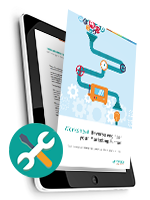In our previous post, we explained that a complex business negotiation is much like a chess game. It’s about making a move and anticipating your customer’s next moves. One of our customers, a packaging company, recently learned this by following our Complex Negotiations Implementation Track, an intense training & development program for sales teams and management professionals. Throughout the process, our customer started to have a pretty good idea of what they were doing right and should do more of, what they needed to stop doing, and what they needed to start doing. We packed all the valuable lessons in a practical overview.
What they need to CONTINUE doing
Have strategic conversations
Before going into the negotiation and even quotation phase, start by exploring the customer’s challenges and priorities for improvement. During preparations, also talk to technical teams or people on the work floor.
Sell the value, not the product
Sales reps like to see their customer relationship as a partnership, where they jointly work on Total Cost of Ownership. This is a much better choice than just defending the value or margin on your product. To do this successfully, you need to be able to prove the value you are offering, whether it’s a cost reduction, cost avoidance, increased revenue, or decreased risk.
You need to make clear that taking your company out of the equation would have a negative impact, one that outweighs the potential price gain from working with a cheaper vendor. The value you offer, including the specialty services on top of your product, is something unique.
Prepare, prepare, and then prepare some more
Hamlet knew: readiness is all. Preparation does make a difference. Prepare your meetings and calls by inputting data and insights from the customer in a structured way and always determine a next objective before starting any new customer interaction.
What they need to STOP doing
Give discounts
Discounts don’t exist. Concessions are always a value transfer. Giving a discount without getting something in return will undermine your integrity and credibility. You are always offering the best price as part of your partnership. That is why you need something in return when your customer needs a lower price.
Enter price negotiations before issues are solved
Before going into the negotiation endgame (where you discuss what to give and take), you should reconfirm all actions that have been agreed upon and that have led to resolving all objections and concerns. It makes no sense to start your endgame discussion when some issues are still on the table.
Oversell
Don’t talk about features or benefits before you are sure that your customer will perceive these as valuable. You need clear confirmation from your customer about the relevance of your features and benefits.
Ask self-serving questions
Questions like ‘when are you taking a decision?’ do not help the customer. Instead, ask things like ‘by when would you like to see the first shipment or implementation?’
Assume things
It’s dangerous to assume things. What happened yesterday or today, will not necessarily happen tomorrow. Don’t assume something to be true even if it is true 99% of the time. Instead discuss it with your customer and get confirmation. Remember: one mistake with one customer is 100% failure.
“Give” before preparing a give and take list
You should always have a list of “gives and takes” before entering a negotiation. You need to know what concessions the customer is willing to do in exchange for your give list. Remember, it’s not wise to start giving before the Middlegame (all non-price related matters) has ended.
What they need to START doing
Ask the magic opening question
‘What has changed since the last time we spoke’ is a great opening question. You don’t always know what has happened since you last spoke with your customer, so you should ask this question every time before going into the meeting agenda.
Close every meeting
ABC – Always Be Closing: try to get as close as possible to your next objective. Summarize what is agreed upon and ask for confirmation.
Use the pre-close technique
You have explored give/take scenarios and you have confirmed these with your internal team/management. The next thing you want to do is apply the pre-closing technique. This means that you assess the mood of the buyer before asking for the sale, so you can move your prospect forward more easily.
Use the Game Plan template
When reaching the Middlegame (resolving objections and concerns), use the Game Plan template. This is a tactical support tool which challenges you on all levels.
Assess the Balance of Power
Before going into the end game, assess the Balance of Power to prevent procurement from using pressure and emotion as a negotiation tactic. Many sales professionals underestimate the power they have over the customer. You might be surprised about the impact you have on a customer when you talk about what they would lose when moving to a competitor or what they would gain when they do (more) business with you. If you negotiate with more confidence, you will achieve more margin.
Let’s play chess
Negotiations are much like chess. And when you apply these lessons learned you’re much more likely to make the best moves and win the game.
Even if you’re an experienced sales professional, there’s something to be learned here. Based upon my own sales leadership experience, I firmly believe it’s good to be challenged sometimes, especially when you are confronted with changing circumstances, or when you have been in the same company or business for quite some time.
Just like our packaging customer, it’s a great, eye-opening exercise to draft your own start – stop – continue plan. In fact, I believe this can benefit any sales professional, whether you are experienced or not. It’s useful to always refresh your skills, polish your good habits, and have a fresh pair of eyes looking over your shoulder.
My colleagues and I have supported many experienced and senior professionals in this. If you are looking for a negotiation trajectory, similar to what we have offered to our packaging customer, we can be that partner for you.



 Els Costers
Els Costers

 Pascal Persyn
Pascal Persyn





 Nicolas Dejehansart
Nicolas Dejehansart